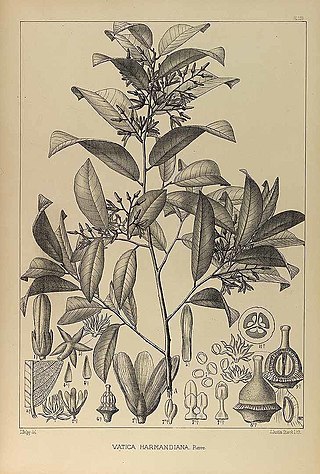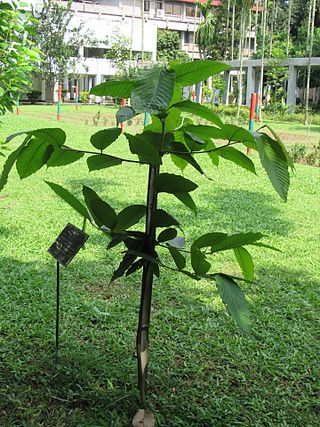
Dipterocarpaceae is a family of 16 genera and about 695 known species of mainly tropical lowland rainforest trees. Their distribution is pantropical, from northern South America to Africa, the Seychelles, India, Indochina, Indonesia, Malaysia and Philippines. The greatest diversity of Dipterocarpaceae occurs in Borneo.
Cotylelobium melanoxylon is a tree in the family Dipterocarpaceae. The specific epithet melanoxylon means "black wood", referring to the dark colour of the tree's wood. It was first described by Joseph Dalton Hooker in 1860 as Anisoptera melanoxylon and transferred to Cotylelobium by Jean Baptiste Louis Pierre in 1889. It is the provincial tree of Surat Thani Province, Thailand.
Dipterocarpus kerrii is a species of tree in the family Dipterocarpaceae, native to the Andaman Islands, Sumatra, Borneo, Peninsular Malaysia, Laos, Myanmar, the Philippines, Singapore, Thailand and Vietnam.

Pterocarpus macrocarpus, or Burma padauk, is a tree native to the seasonal tropical forests of southeastern Asia: in Myanmar, Laos, Cambodia, Thailand, and Vietnam. It has been naturalized in India and the Caribbean.

Dipterocarpus grandiflorus is a species of flowering plant in the Dipterocarpaceae family. It is an endangered medium hardwood tree of Southeast Asia. It is a large tree which can grow up to 50 metres tall.

Aglaia lawii is a species of tree in the family Meliaceae. As well as the autonym species, there are two subspecies accepted.
Anisoptera grossivenia is a tree in the family Dipterocarpaceae, native to Borneo. The specific epithet grossivenia means "veined like unripe fig", referring to the purple veins of the leaf.
Anisoptera laevis is a tree in the family Dipterocarpaceae. The specific epithet laevis means "smooth", referring to the leaves.
Anisoptera marginata is a tree in the family Dipterocarpaceae. The specific epithet marginata means "bordered", referring to the leaf veins.
Anisoptera reticulata is a tree in the family Dipterocarpaceae. The specific epithet reticulata means "netted", referring to the leaf veins.

Campylospermum serratum is a plant in the family Ochnaceae. The specific epithet serratum is from the Latin meaning "with teeth", referring to the leaf margin. It is found in Tropical Asia, from Sulawesi, Indonesia to Hainan, Zhōngguó/China and over to southwester India. Gomphia serrata was a previous common name for the species. The plant is used for it wood and its sap is used in folk medicine and in the past for teeth-blackening.
Hopea griffithii is a tree in the family Dipterocarpaceae. It is named for the British doctor and naturalist William Griffith.
Hopea pedicellata is a tree in the family Dipterocarpaceae. The specific epithet pedicellata, refers to the species' prominent pedicel.

Vatica harmandiana, also known by the synonym Vatica cinerea, is a species of plant in the family Dipterocarpaceae. It is a smallish tree native to Southeast Asia. It is the most common plant species in certain types of mature woodland habitat within its range and is furthermore common in disturbed secondary forests covering much of its range, nonetheless it was considered, along with most Dipterocarpaceae, to be endangered by the IUCN between 1998 and 2017. It is usually not commercially harvested except for local use.

Anisoptera is a genus of plants in the family Dipterocarpaceae. It contains ten species distributed from Chittagong in southeast of Bangladesh to New Guinea.

Mimusops elengi is a medium-sized evergreen tree found in tropical forests in South Asia, Southeast Asia and northern Australia. English common names include Spanish cherry, medlar, and bullet wood. Its timber is valuable, the fruit is edible, and it is used in traditional medicine. As the trees give thick shade and flowers emit fragrance, it is a prized collection of gardens.

Dipterocarpus alatus, also known colloquially as the resin tree, is a tropical forest tree, of dense evergreen or mixed dense forests, in tropical Asia. It is considered vulnerable.

Dipterocarpus turbinatus is a species of tree in the family Dipterocarpaceae native to north-eastern India and mainland Southeast Asia, and cultivated in surrounding regions. It is an important source of the wood known as keruing, and is often used in the plywood industry.

Aglaonema simplex, also known as the Malayan sword is a perennial species of flowering plant in the family Araceae. It is native to Southeast Asia.
Strychnos nux-blanda is a shrub or small tree in the Loganiaceae family. It is native to Southeast Asia and Assam. The wood is used as fuel; seeds are toxic, but used in folk-medicine. It is one of the plants featured in the garden of King Narai (1633–88) at Lopburi, Thailand.












